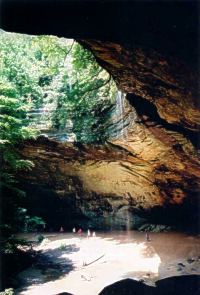 the others in this region; the middle layer of the Blackhand has been weathered or eroded while the more resistant upper and lower zones have
remained intact.
the others in this region; the middle layer of the Blackhand has been weathered or eroded while the more resistant upper and lower zones have
remained intact. | Hocking Hills State Parks - Ash Cave | click photo to see larger picture |
In the southernmost reaches of Hocking Hills is Ash Cave - beyond doubt the most spectacular feature of the entire park. Ash Cave is the largest, most impressive recess cave in the state.
The approach to Ash Cave is through a narrow gorge lined with stately hemlocks, massive beech trees and various other hardwoods. The valley floor offers brilliant displays of wildflowers in the all seasons including large flowered trillium, Dutchman’s breeches, trout lily, Jack-in-the Pulpit and jewelweed. The narrow gorge is approximately one-fourth mile in length and with astonishing suddenness gives way to the tremendous overhanging ledge and cave shelter.
The horseshoe-shaped cave is massive; measuring 700 feet from end to end, 100 feet deep from the rear cave wall to its front edge with the rim
rising 90 feet high. A small tributary of the East Fork of Queer Creek cascades over the rim into a small plunge pool below. The cave was formed
like the others in this region; the middle layer of the Blackhand has been weathered or eroded while the more resistant upper and lower zones have
remained intact.
the others in this region; the middle layer of the Blackhand has been weathered or eroded while the more resistant upper and lower zones have
remained intact.
Ash Cave is named after the huge pile of ashes found under the shelter by early settlers. The largest pile was recorded as being 100 feet long, 30 feet wide and 3 feet deep. The source of the ashes is unknown but is believed to be from Indian campfires built up over hundreds of years. One other belief is that the Indians were smelting silver or lead from the rocks. Still another theory claims that saltpeter was made in the cave. No matter the source, several thousand bushels of ashes were found. A test excavation of the ashes in 1877 revealed sticks, arrows, stalks of coarse grasses, animal bones in great variety, bits of pottery, flints and corn cobs.
It is obvious the cave was used for shelter by early inhabitants. The recess shelter also served as a workshop for Indians where maidens ground corn and prepared meals, and where braves fashioned arrow and spear points and skinned and dressed game. The cave provided a resting place for travelers along the main Indian trail which followed the valleys of Queer and Salt creeks. This trail connected the Shawnee villages and the Kanawha River region of West Virginia with their villages along the Scioto River at Chillicothe. The trail was used after the start of the frontier wars to march prisoners captured along the Ohio River to the Indian towns on the upper Scioto River. The old Indian trail is now State Route 56.
More recent uses of Ash Cave were for camp and township meetings. Pulpit Rock, the largest slump block at the cave’s entrance served as the pulpit for Sunday worship service until a local church could be built. The cave lends itself well for large gatherings due to its enormous size and incredible acoustic qualities. In fact, two spots under the recess have the qualities of a “whispering gallery.”
Picnic facilities are offered adjacent to the parking lot. The restrooms and trail leading to Ash Cave are wheelchair accessible.
View Ash Cave Hiking Trail Map.
View Ash Cave Water Falls from the bottom of the gorge.